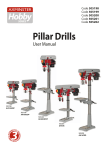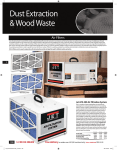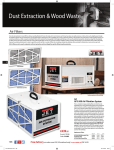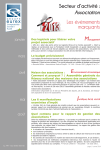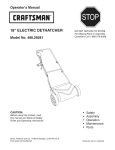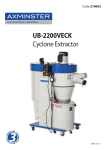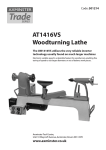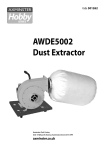Download Axminster RDC100H Instruction manual
Transcript
Code 501269 RDC100H Vacuum Extractor Axminster Tool Centre, Unit 10 Weycroft Avenue, Axminster, Devon EX13 5PH axminster.co.uk Index of Contents Page No Index of Contents Declaration of Conformity What’s in the Box General Instructions for 230V Machines Specific Safety for Dust Extractors Specification Assembly Workshop Setup Illustration and Parts Description Changing the Micron Filter Bag Maintenance Parts Breakdown Parts List 02 02 03 04 05 06 06-07 08-09 10-11 12-13 13 14 15 Declaration of Conformity Copied from CE Certificate The undersigned, Galen Chun authorised by Qingdao DandD Electromechanical Technnologies Co., Ltd. Jiaozhou Branch No.1 DandD Road, Jiaobei Town, Jiaozhou City,Qingdao, Shandong, China declares that this product Model number RDC100H manufactured by Qingdao D&D Electromechanical Technnologies Co. is in compliance with the following standards or standardisation documents in accordance with Council Directives EN 60335-2-69:2003+A1:2004 EN 603351:2002+A1:2004+A11:2004+A2:2006+A12:2006 EN 50366:2003+A1:2006 symbols below advise that you follow the correct Warning The safety procedures when using this machine. Fully read manual and safety instructions before use 02 Ear protection should be worn Eye protection should be worn Dust mask should be worn HAZARD Motor gets hot What’s in the Box Model Number RDC100H 1 No. Vacuum Extractor with filter and micron bag fitted. A 1 No. Flexible Hose B 1 No. Flexible Hose Clamps C 1 No. 100mm Adaptor Moulding D 4 No. Micron Filter Bags E Code 210091 1 No. Instruction Manual Having unpacked your vacuum extractor and its accessories please dispose of any unwanted packaging properly. The packaging is biodegradable. A Remove items from inside the drum E B C D 03 General Instructions for 230V Machines Good Working Practices/Safety The following suggestions will enable you to observe good working practices, keep yourself and fellow workers safe and maintain your tools and equipment in good working order. ! WARNING!! Primary Precautions KEEP TOOLS AND EQUIPMENT OUT OF THE REACH OF YOUNG CHILDREN Mains Powered Tools and Machines These machines are supplied with a moulded 13 Amp. Plug and 3 core power cable. Before using the machine inspect the cable and the plug to make sure that neither are damaged. If any damage is visible have the damaged item inspected/repaired by a suitably qualified person. If it is necessary to replace the plug, it is preferable to use an ‘unbreakable’ type that will most resist damage. Only use a 13 Amp plug, and make sure the cable clamp is tightened securely. Fuse as required. If extension leads are to be used, carry out the same safety checks on them, and ensure that they are correctly rated to safely supply the current that is required for your machine. Remember, most machines or tools have handles or holding positions, the power cable is not one of them. Work Place/Environment. The machine is not designed for use outside. Keep the machine clean; it will enable you to more easily see any damage that may have occurred. Clean the machine with a damp soapy cloth if needs be, do not use any solvents or cleaners, as these may cause damage to any plastic parts or to the electrical components. Keep the work area as uncluttered as is practical, this includes personnel as well as material. Under no circumstances should CHILDREN be allowed in work areas. It is good practice to leave the machine unplugged until work is about to commence, also make sure to unplug the machine when it is not in use, or unattended. To avoid inadvertent ‘start up’; if your machine is not fitted with a NVR system, ensure the switch is always returned to the OFF position. Once you are ready to commence work, remove any tools, objects or items that could inadvertently get ‘sucked up’ by the machine (if any) and place safely out of the way. Re-connect the machine, ensuring the power cable is not ‘snagged’ or routed where it could be tripped over as you move about the workshop; it is not too close to an unguarded heat source, or is laid over or around a sharp edge. If the work you are carrying out is liable to generate flying grit, dust or chips, wear the appropriate safety clothing, goggles, gloves, masks etc. If the work operation appears to be excessively noisy, wear ear-defenders. If you wear your hair in a long style, wearing a cap, safety helmet, hairnet, even a sweatband, will minimise the possibility of your hair being caught up in the rotating parts of the machine, likewise, consideration should be given to the removal of rings and wristwatches if these are liable to be a ‘snag’ hazard. Consideration should also be given to non-slip footwear, etc. DO NOT work with cutting or boring tools of any description if you are tired, your attention is wandering or you are being subjected to distraction. A deep cut, a lost fingertip or worse; is not worth it! 04 DO NOT use this machine within the designated safety areas of flammable liquid stores or in areas where there may be volatile gases. There are very expensive, very specialised machines for working in these areas, THIS IS NOT ONE OF THEM.Above all, OBSERVE…. make sure you know what is happening around you, and USE YOUR COMMON SENSE. Specific Safety for Dust Extractors DO NOT use this machine as a vacuum cleaner, try to keep the waste medium to wood by-products. Do not uplift workshop floor debris (stones, nails, screws, paper etc., etc). Be aware that wood dust is an explosive medium. DO NOT allow any ‘naked light’ source to occur anywhere near the machine. This includes cigarettes, matches, etc, and do not place the machine near any unprotected light bulbs, that could possibly get broken. If you are not using ‘clear’ extraction hose, periodically remove the hose to check that the inlet to the machine is not getting restricted. If possible, try to connect everything together electrically, to eliminate static shocks. Try to route the power cable and the hosing away from busy walkways. DO NOT allow the inlet to become ‘dead ended’, or block or restrict the outlet, this puts undue work on the motor and can lead to overheating. ! NOTE!! DO NOT FIT PLASTIC WASTE BAGS TO THIS MACHINE 05 Specification Model Product Code Rating Power Air Flow Noise Level Particle Size Hose Diameter Overall L x W x H Weight RDC100H 501269 Hobby 1,100W 180m³/hr 85dB(A) 1 micron 100mm 400 x 400 x 700mm 10kg Assembly Your Vacuum Extractor is fully assembled, except for the Flexible Hose and 100mm Adaptor Moulding, you will find all parts inside the vacuum extractor, by removing the vacuum motor head. You will also require a flat ended screwdriver. Please follow the instructions below: 1 Remove the motor head by unlatching the motor clamping ring (A). A 2 06 Remove the motor head clamping ring (A) and place safely aside. Assembly Dust extraction out 4 3 A C B Lift the motor head assembly and remove all the parts from inside the drum, if you haven’t already done so. Replace the motor head and clamping ring (A). Locate one of the two hose clamps (C), place over one of the ends of the hose (B) and push the hose over the dust extraction outlet. C 6 5 B D Secure the hose in position by tightening the hose clamp (C)using a flat edge screwdriver. Locate the 100mm Adaptor Moulding (D) and the remaining hose clamp (C). Place the clamp over the hose as before, insert the adaptor (D) into the end of the hose and tighten the hose clamp (C). 7 Secure the hose in position by tightening the hose clamp (C) using a flat edge screwdriver. C 07 Workshop Setup This machine will cope with waste shavings from most bench-top machines and the smaller floor standing machines, especially bandsaws, circular saws, bench top surface planers and hand-held power tools (with the accessory power tool hose kit), (code 718085). Below are two examples showing the vacuum extractor connected to a hand-held sander and floor standing bandsaw. The picture above shows the vacuum extractor with a 100mm to 51mm reducer adaptor, (code 210616) enabling it to be connected to a hand-held sander. NUMATIC Extraction Hose Kit (Code 718085) 08 The picture above shows the vacuum extractor connected to a floor standing bandsaw, using the 100mm adaptor moulding that comes as standard. Workshop Setup 63mm Dust Extraction Kit (Code 410063) Another option is a ducting system package complete with elbows, blast gates and adaptors for connecting up your machines to a workshop extractor. Simply fix a horizontal pipe to the wall or ceiling with the clips supplied and then take branch pipes to exactly where the extraction points are needed in the workshop, using the T junctions and 63mm flexible hose. The picture above shows the vacuum extractor connected to the 63mm dust extraction kit. 09 Illustration and Parts Description Motor head clamp Carryng handle Filter and micron bag Motor assembly Hose Drum 100mm Adaptor moulding 10 Illustration and Parts Description ON OFF ON/OFF Switch 11 Changing the Micron Filter Bag ! DISCONNECT THE VACUUM EXTRACTOR FROM THE MAINS SUPPLY 1 2 A A Remove the motor head by unlatching the motor clamping ring (A). 3 Remove the motor head clamping ring (A) and place safely aside. 4 Micron bag and filter assembly Lift the motor head assembly away from the drum. 5 Remove the micron bag and filter from the motor assembly and clean the motor assembly and filter using an air line or vacuum cleaner. 6 B 12 Insert the filter into a new micron bag and tuck in the bag end down into the filter, see fig B. Changing the Micron Filter Bag 7 8 Replace the micron bag and filter assembly, push firmly so the assembly is flush up against the motor casing. Lower the motor head assembly back onto the drum, replace the motor clamping ring and lock it, securing it in position. Connect the Vacuum Extractor to the mains and continue with operation. Maintenance ! DISCONNECT THE VACUUM EXTRACTOR FROM THE MAINS SUPPLY Weekly •CHECK the inlet duct, remove any accumulated debris. •CHECK the inlet hose for splits and cracks, repair as necessary. •CHECK the micron bag for wear and tear. If wear or fraying is occurring, replace the micron bag, see pages 11 and 12 “Changing the Micron Bag”. •CHECK the motor for dust, sawdust, shavings etc, build up. If this has occurred, blow out with L.P. air or clean with a vacuum cleaner. (If ‘blowing out’ remember to wear eye protection and dependent on the type of dust, consideration should be given to face masking). •CHECK the drum container and empty if full. Monthly •Carry out the weekly checks. •Dependent on usage clean the vacuum extractor over using a damp cloth. 13 Parts Breakdown 14 Parts List ITEM NAME QTY 1 Shaving Drum Container 1 2 Motor Head Clamping Ring 1 3 Cartridge Filter 1 4 Motor 1 5 Screw ST5.5X15 3 6 Container Lid 1 7 Screw M5xl0 4 8 Long Sponge 1 9 Round Sponge 1 10 Right Motor Casing 1 11 Screw M5x45 1 12 Screw M5x25 3 13 M5 Screw (black) 3 14 Left Motor Casing 1 15 Cable 1 16 On/Off Switch 1 17 Cable Gland 1 18 Ø5 Spring Washer 12 19 Ø5 Washer 1 20 Rubber Cushion 2 21 Micron Filter Bag 1 22 Hose Coupling 1 1 23 Hose Clamps 2 24 Hose Coupling 2 1 25 Flexible Hose 1 26 Screw M5x12 4 27 M5 nut (white) 4 15 Please dispose of packaging for the product in a responsible manner. It is suitable for recycling. Help to protect the environment, take the packaging to the local recycling centre and place into the appropriate recycling bin. Only for EU countries Do not dispose of electric tools together with household waste material. In observance of European Directive 2002/96/EC on waste electrical and electronic equipment and its implementation in accordance with national law, electric tools that have reached the end of their life must be collected separately and returned to an environmentally compatible recycling facility.
















